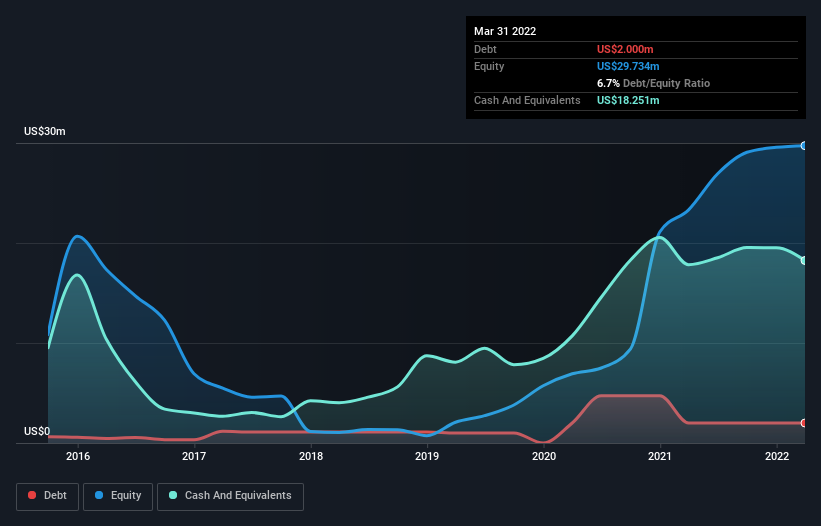- United States
- /
- Healthcare Services
- /
- NasdaqCM:JYNT
These 4 Measures Indicate That Joint (NASDAQ:JYNT) Is Using Debt Reasonably Well
David Iben put it well when he said, 'Volatility is not a risk we care about. What we care about is avoiding the permanent loss of capital.' When we think about how risky a company is, we always like to look at its use of debt, since debt overload can lead to ruin. We note that The Joint Corp. (NASDAQ:JYNT) does have debt on its balance sheet. But the real question is whether this debt is making the company risky.
Why Does Debt Bring Risk?
Debt assists a business until the business has trouble paying it off, either with new capital or with free cash flow. Ultimately, if the company can't fulfill its legal obligations to repay debt, shareholders could walk away with nothing. However, a more usual (but still expensive) situation is where a company must dilute shareholders at a cheap share price simply to get debt under control. Of course, plenty of companies use debt to fund growth, without any negative consequences. The first thing to do when considering how much debt a business uses is to look at its cash and debt together.
See our latest analysis for Joint
How Much Debt Does Joint Carry?
The chart below, which you can click on for greater detail, shows that Joint had US$2.00m in debt in March 2022; about the same as the year before. But on the other hand it also has US$18.3m in cash, leading to a US$16.3m net cash position.

How Healthy Is Joint's Balance Sheet?
According to the last reported balance sheet, Joint had liabilities of US$20.6m due within 12 months, and liabilities of US$34.7m due beyond 12 months. On the other hand, it had cash of US$18.3m and US$3.61m worth of receivables due within a year. So its liabilities outweigh the sum of its cash and (near-term) receivables by US$33.5m.
Since publicly traded Joint shares are worth a total of US$243.2m, it seems unlikely that this level of liabilities would be a major threat. However, we do think it is worth keeping an eye on its balance sheet strength, as it may change over time. While it does have liabilities worth noting, Joint also has more cash than debt, so we're pretty confident it can manage its debt safely.
The modesty of its debt load may become crucial for Joint if management cannot prevent a repeat of the 53% cut to EBIT over the last year. When it comes to paying off debt, falling earnings are no more useful than sugary sodas are for your health. The balance sheet is clearly the area to focus on when you are analysing debt. But it is future earnings, more than anything, that will determine Joint's ability to maintain a healthy balance sheet going forward. So if you want to see what the professionals think, you might find this free report on analyst profit forecasts to be interesting.
Finally, a company can only pay off debt with cold hard cash, not accounting profits. While Joint has net cash on its balance sheet, it's still worth taking a look at its ability to convert earnings before interest and tax (EBIT) to free cash flow, to help us understand how quickly it is building (or eroding) that cash balance. Happily for any shareholders, Joint actually produced more free cash flow than EBIT over the last three years. There's nothing better than incoming cash when it comes to staying in your lenders' good graces.
Summing Up
While Joint does have more liabilities than liquid assets, it also has net cash of US$16.3m. The cherry on top was that in converted 128% of that EBIT to free cash flow, bringing in US$5.8m. So we don't have any problem with Joint's use of debt. There's no doubt that we learn most about debt from the balance sheet. However, not all investment risk resides within the balance sheet - far from it. These risks can be hard to spot. Every company has them, and we've spotted 2 warning signs for Joint you should know about.
If you're interested in investing in businesses that can grow profits without the burden of debt, then check out this free list of growing businesses that have net cash on the balance sheet.
New: Manage All Your Stock Portfolios in One Place
We've created the ultimate portfolio companion for stock investors, and it's free.
• Connect an unlimited number of Portfolios and see your total in one currency
• Be alerted to new Warning Signs or Risks via email or mobile
• Track the Fair Value of your stocks
Have feedback on this article? Concerned about the content? Get in touch with us directly. Alternatively, email editorial-team (at) simplywallst.com.
This article by Simply Wall St is general in nature. We provide commentary based on historical data and analyst forecasts only using an unbiased methodology and our articles are not intended to be financial advice. It does not constitute a recommendation to buy or sell any stock, and does not take account of your objectives, or your financial situation. We aim to bring you long-term focused analysis driven by fundamental data. Note that our analysis may not factor in the latest price-sensitive company announcements or qualitative material. Simply Wall St has no position in any stocks mentioned.
About NasdaqCM:JYNT
Flawless balance sheet with moderate growth potential.
Market Insights
Community Narratives



